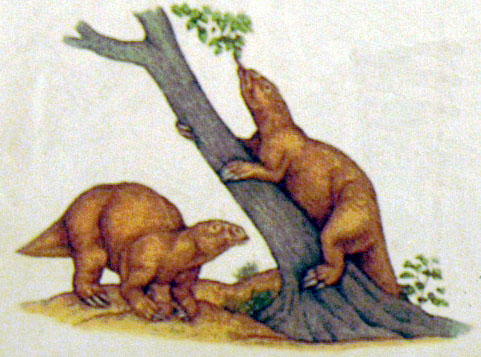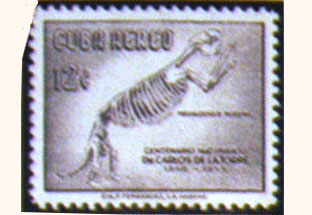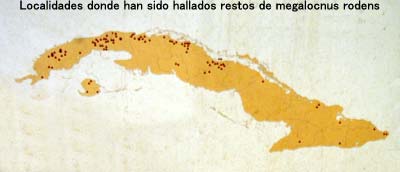The Giant Sloth Bear Megalocnus Rodens
The Prehistoric Mammal That Lived in Cuba
Information provided by the National Museum of Natural History of Cuba, adapted and translated by Danil Ren.

The natural giant Cuban sloth bear, whose specie is megalocnus rodens, was discovered in Cuba in 1910 by Dr. Carlos de la Torre y Huerta, as you can see him in the picture below, with the skeleton of the animal and the bust of the Cuban scientist Felipe Poey, one of the main promoters of the Natural History Museum of Cuba.

It's documented that this specie of sloth bear was the bigger terrestrial mammal of Cuba. According to various studies, the megalocnus rodens comes from South America and it began living in Cuba about 30 millions years ago. The animal was extinguished about 4200 years ago. The exact reasons for this extinction are not well known.
The Cuban megalocnus rodens was an imposing animal, its typical length was a meter and half and it weighted about 200 kg, almost the same weight than a brown adult bear. But, despite of its aspect, the animal was vegetarian.
In the Caribbean, other species of sloth bears also existed, but not of the same size, like the imagocnus, the mesocnus and the neocnus, the smallest of all, since it had only 40 centimeters of length. But the Cuban megalocnus rodens, in spite of its size, had predators, for example the vampire bath (also extinct) that ate its blood, the giant owl or the Cuban eagle, as well as several other giant birds.
According to the opinion of some scientists, when the first aborigines arrived to Cuba, the megalocnus rodens were already about to extinguish, even if it lived with humans for about one thousand years. Some theories even argue that the megalocnus rodens became their feed and this would probably be the final cause of its extinction.
Finally, it's said that the megalocnus rodens lived in several regions of Cuba, but there were much more remains in the western and central provinces, including the Youth Island.
The skeleton found in the Museum of Natural History of Cuba is one of the most worthful pieces of it. It is the second existing specimen in the world, the other is preserved in the New York museum of the same name. The one present in Cuba come from plenty of the fossil material found in 1910, in the Ciego Montero basin, of the Cienfuegos province, one where it was found the majority of the remains.
The already mentioned Cuban naturalist Dr. Carlos de la Torre y Huerta, sent that material to the American Museum of Natural History of New York for its study. Obviously the existing remain didn't come complete. They were mounted in the New York museum and they came up with two almost complete skeletons, one of them, as we know, is preserved in Cuba. This skeleton is even printed in a Cuban stamp in 1956, as a tribute to the centenary of Dr Carlos de la Torre birth.

Conclusion
The megalocnus rodens is one of the most authentic prehistoric animals of Cuba and also one of the more impressing. It is not endemic because, as we have said, it comes from other regions of America, but its presence in the Cuban archipelago was determinant, especially because its extinction coincided with the arrival of the Aboriginal in Cuba. And this opens an entire field for the Cuban science study. I repeat, this relic is the second existing in the world and it is the more complete of the two. Its sole visit would justify a trip to Cuba, especially if you are a natural story enthusiast.








